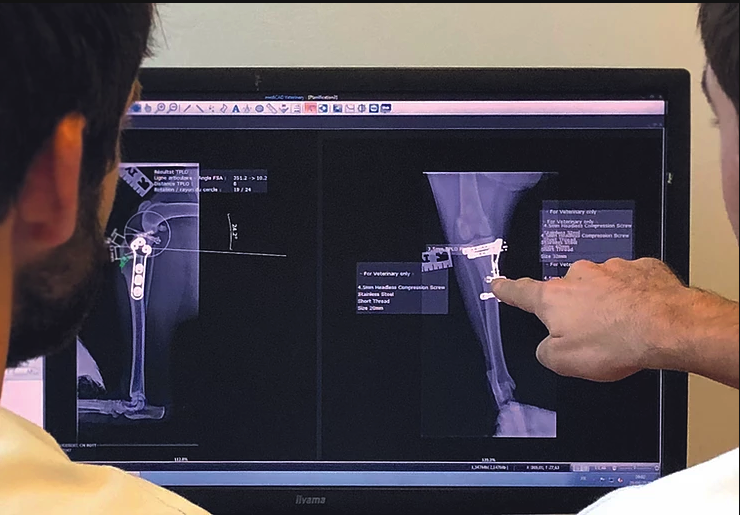



Published, 21.10.2022
Interview with Professor Manassero – ENVA
Using digital planning solution.
The National Veterinary School of Alfort (EnvA) at the gates of Paris, is one of four veterinary schools in France. Awarding the diploma of Veterinary Doctor after seven years of theoretical and clinical training, EnvA is on the list of European establishments recognized as competent by the European Association of Veterinary Education Establishments (EAEVE).

mediCAD GmbH:
What was your motivation to migrate to a digital planning solution and what additional value does it bring toyou within the framework of the prosthesis fitting activity within the ENVA? (reliability , traceability, DPI, …)
Pr. Manassero:
Initially, the desire to switch to a digital planning solution was dictated by a logistical problem and fluidity in acontext where digital X-rays no longer needed to be printed and planning was then easily doney with digital tools. Very quickly, however, the reliability of the use of digital measurement appeared to be a major point pushing usto continue along this path. Digital planning is currently used in our institution mainly for tibial leveling procedures, where it has become almost a standard procedure and is also becoming more and more common in trauma.
mediCAD GmbH:
What would you say overall to our mediCAD® 2D Veterinary tool that you have been using for over a year now?
Pr. Manassero:
I am very satisfied with mediCAD® 2D Veterinary which I‘m now routinely using. Its handling has been very easyand it is a software with many features. In addition, the database of available implants is quite large and constantly evolving, which allows us to adapt quite easily to the implants we have. The export of the planning brings a realplus to the patient files and to the studies to be carried out.
mediCAD GmbH:
What are its assets in the team‘s practice (what are you planning, at what %, forensic aspects, time, time spentin comparison with layers…)?
Pr. Manassero:
Currently we are using mediCAD® 2D Veterinary for the planning of most of the tibial leveling procedures and weare in the process of systematizing it for trauma procedures. After a fairly quick start, the time spent on planningis quite similar or even less than the time spent by using layers ; while allowing us to benefit from a better reliability linked to the IT tool (enlargement, image displacement, etc.). From university side, the use of this softwareis also an undeniable educational asset because it allows to break down the planning step by step (osteotomy simulation, reduction simulation, etc.) and to keep a visual trace of it, while correcting the operator if necessary.
mediCAD GmbH:
How do you measure the benefits of mediCAD® Vet?
Pr. Manassero:
It is currently difficult to precisely measure the benefits of mediCAD® 2D Veterinary in practice, but the reliabilityof the measurements that seem to emerge from it can only encourage us to continue its use. With a few monthsof use now, we are very satisfied with this tool which seems to save us time on preoperative planning (5min fora TPLO planning) and limits the risk of intraoperative errors (position of the saw, size of the implants and in particular screws).
mediCAD GmbH:
Is mediCAD® Vet an essential tool in the overall improvement process for an establishment like ENVA?
Pr. Manassero:
Yes, without a doubt, especially by the possible traceability through the extraction of the operative planning andthe possibility to control the osteosynthesis upstream of the operative procedure in an easier way than with layers. Not using printed X-rays, in addition to the time and cost savings, allows you to avoid all the errors potentiallylinked to this process.
mediCAD GmbH:
According to you, what are the challenges of planning today and in the future and does mediCAD® Vet meet these expectations.
Pr. Manassero:
Like human surgery, veterinary surgery has benefited a lot in the past years, particularly in orthopaedics with significant progress in both the technique of installation thanks to minimally invasive approaches and the use ofimplants and materials, thus improving the care of our patients. However, regardless of the techniques and materials used, in order to benefit from these technical advances it is necessary that the implants are chosen accordingto the patient and positioned in accordance with established rules. Preoperative planning allows us to meet thesetwo requirements.
Of course, it does not replace the surgeon‘s experience and technical skills, but it does allow the surgeon to understand critical points before surgery, the lack of which may be the cause of potentially disabling clinical complications. In that sense, planning certainly improves the surgeon‘s learning curve. This preoperative preparationwork has been carried out by surgeons for many years, and, as with the rest of this surgery, substantial progresshas recently been made thanks to new imaging techniques but also thanks to the progress of computer systems. mediCAD® Vet with its implant database and its planning tools for various procedures meets these needs.
mediCAD GmbH:
Is the evolution towards 3D planning the solution to be generalized to improve the reliability of planning?
Pr. Manassero:
3D planning is yet another step forward by allowing, through the superposition of anatomical structures, amore reliable planning more adapted to each patient. Its major pitfall, in veterinary medicine, is the need toresort to a tomographic examination, which is quite expensive for the owner. However, I remain convinced that the current development of joint prostheses in pets will lead to the development of 3D planning whichwill then surely not appear as a simple aid in the future, but a real tool to guarantee the technique of surgery, and the safety of the patient.